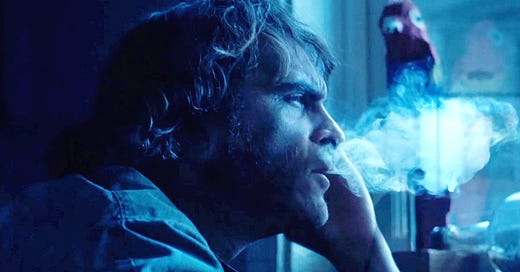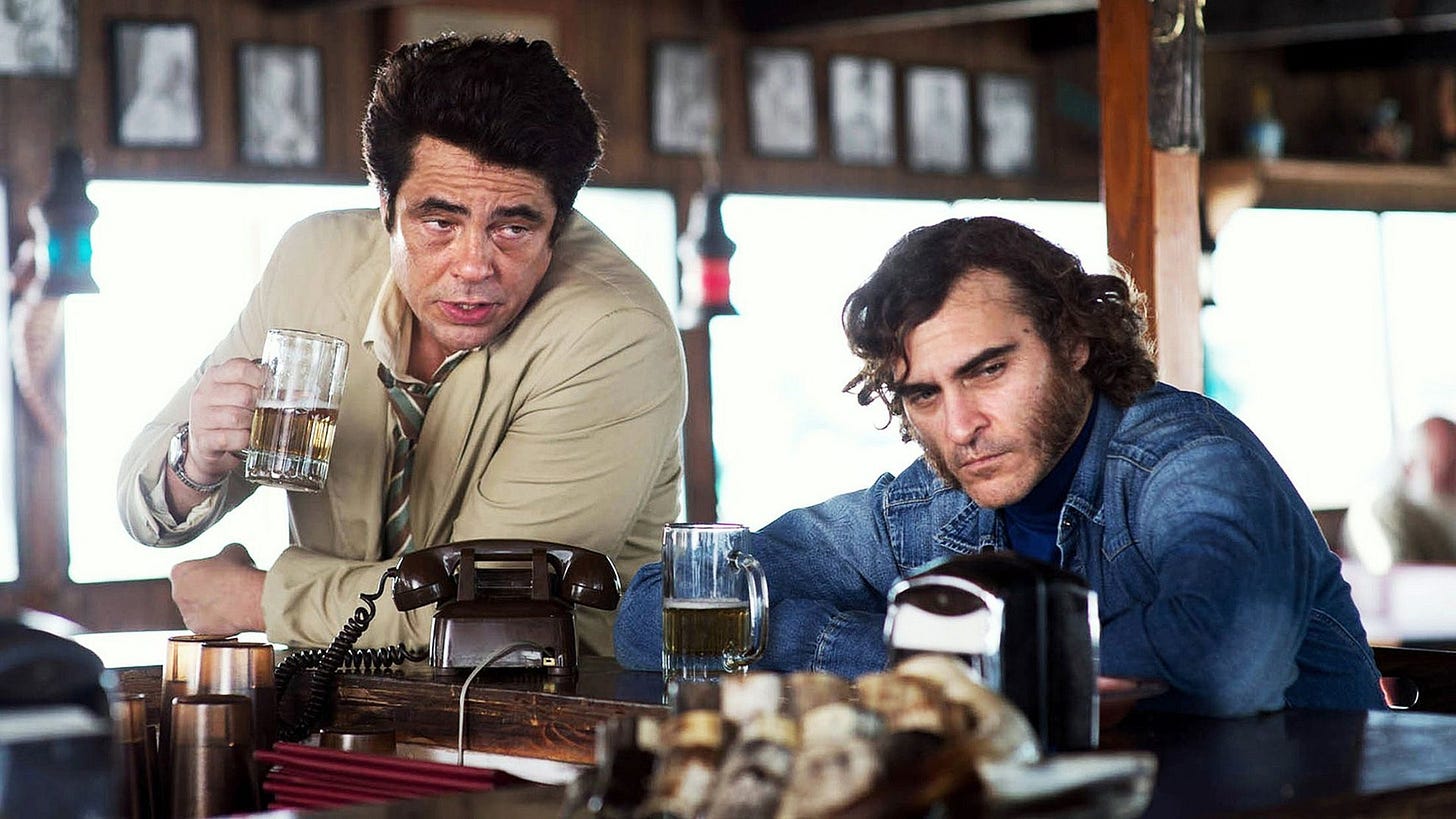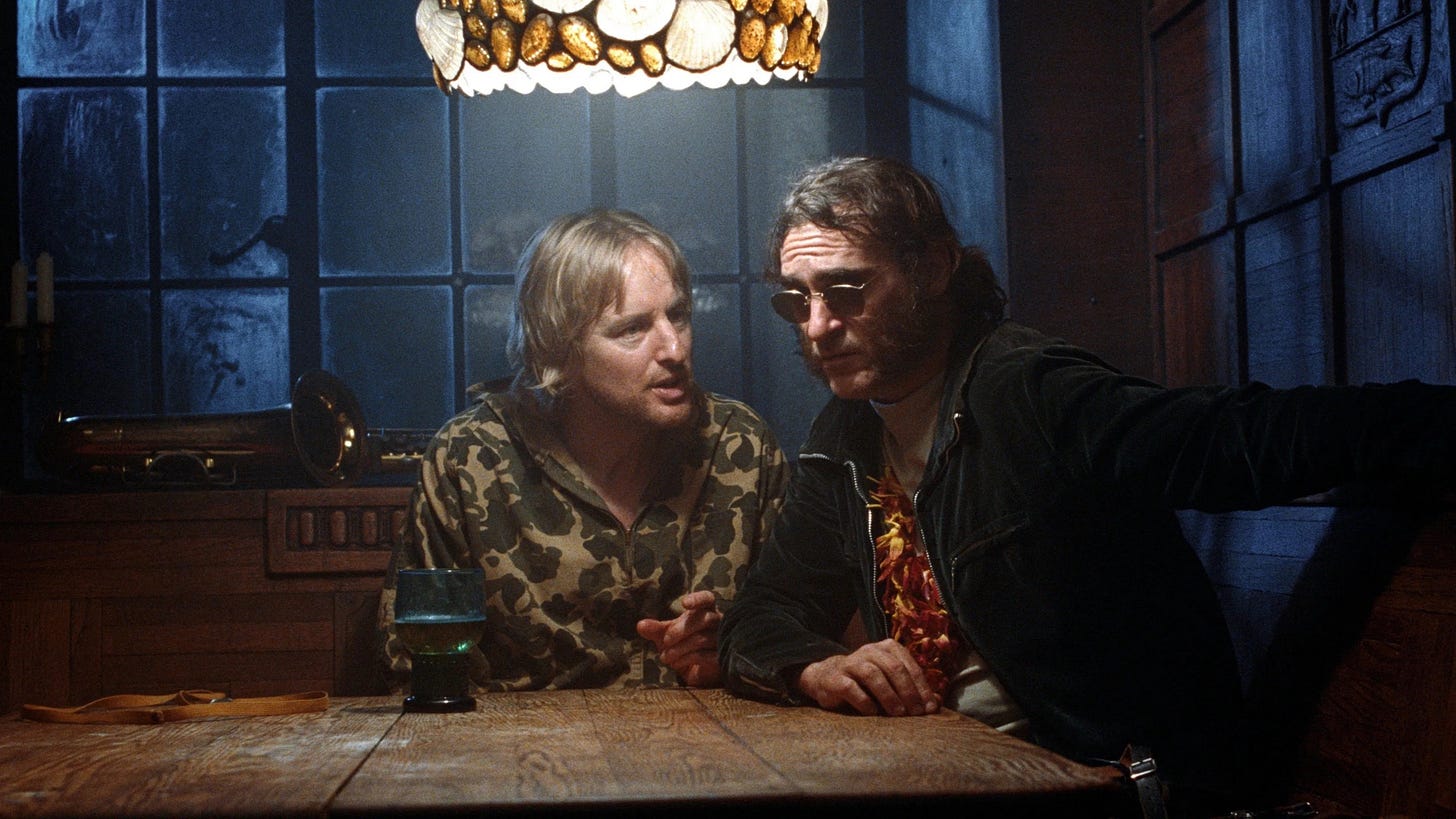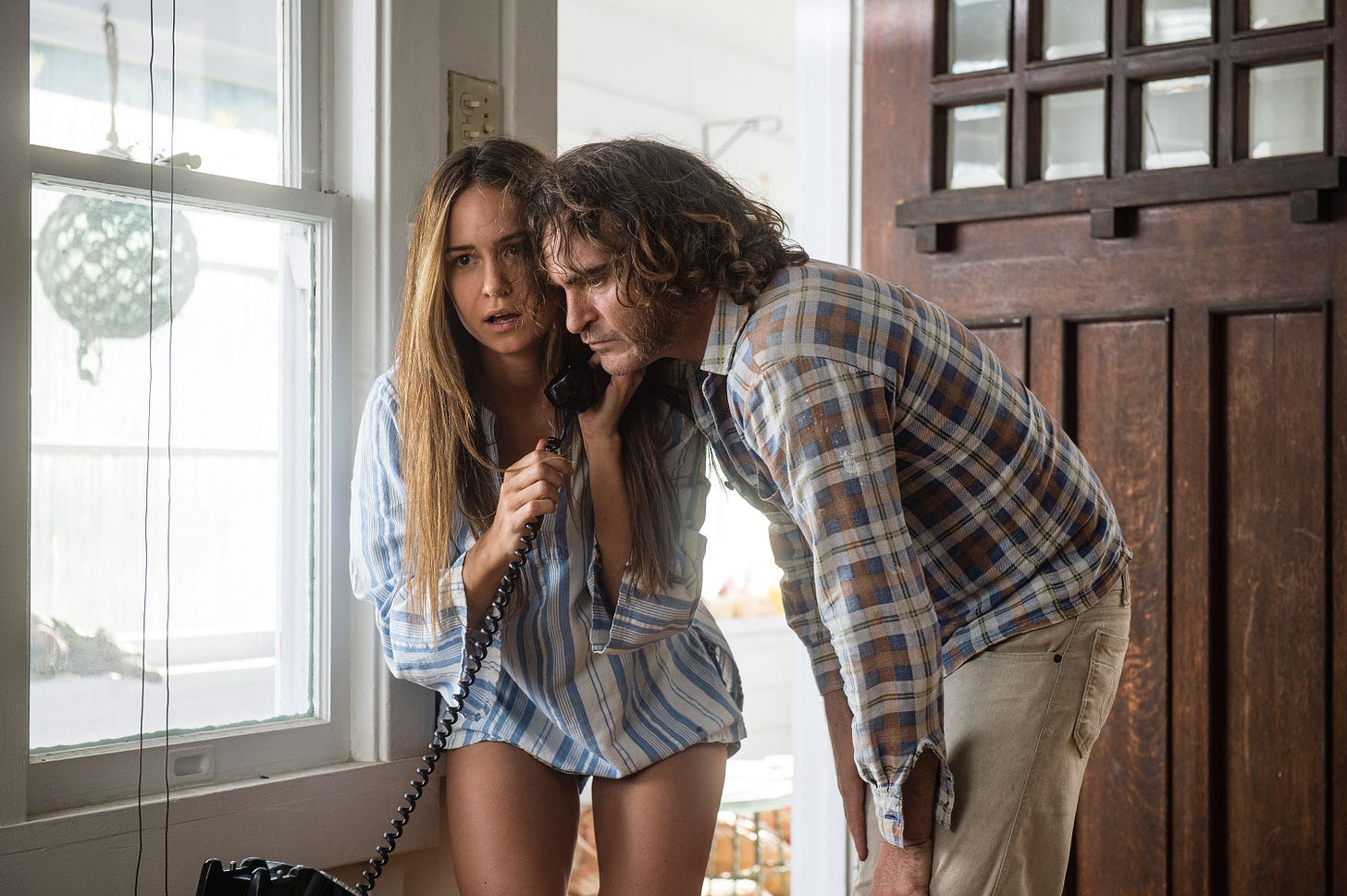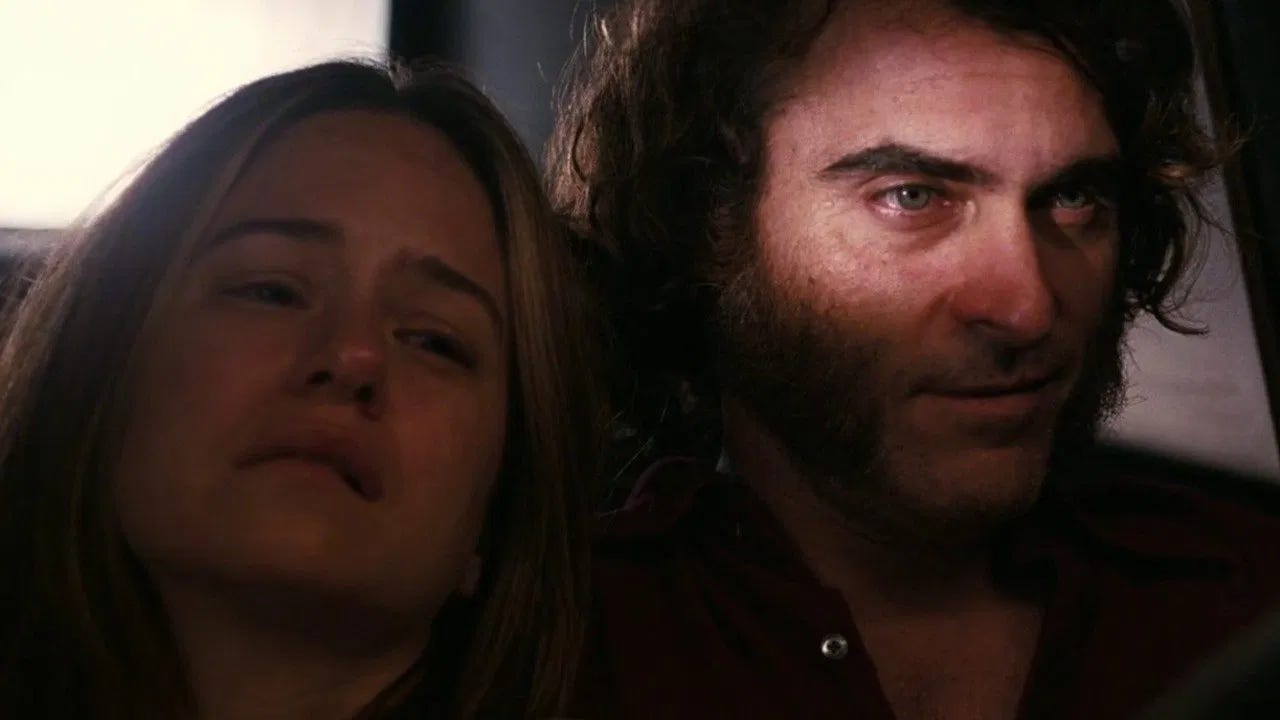Inherent Vice (2014) (dir. Paul Thomas Anderson)
An attempt to see through the fog and find a little sliver of light here in 2025.
“I escape real good” - Japonica Fenway
Me too, Japonica. Which I struggle with. Am I watching too many movies? Listening to too many podcasts? Recording too much? Writing in this Substack to manage and structure my thoughts? Hoping I compose something worthy of my time, your time. We’re all in need of escaping as society begins to unravel. This country is strung-out. It needs to heal. We’re in a complicated relationship with one another and could use some mending. We could use a laugh in 2025. Why?
Well, the orange-hued figure AKA demon-in-chief, this POTUS-elect-reject-reelect, this carnival barker turned national ringmaster, is set up deliberately to avoid repercussion, allow complexity, induce terror—a man whose very name suggests both triumph and the flatulent expulsion of polluted hot air, whose stature defies not only gravity but the very laws of natural physics, whose rhetoric spirals outward in unholy gusts of syntactical entropy, each sentence beginning somewhere near coherence before wandering off into the desert of non sequitur, leaving listeners stranded in a wasteland of half-formed thoughts and truncated logic, while democracy, that grand American experiment, that fragile vessel of collective will, lists dangerously to starboard, taking on water through a thousand pinprick leaks of disinformation with an autocratic chaser, each droplet insignificant alone but together forming a rising tide of epistemological chaos in which truth and manipulation swirl together in patterns too complex for the battered brain to parse, patterns that might, if one could view them from a sufficient distance, reveal themselves as the sigil of some vast and ancient death cult, its adherents gathered in digital temples where they worship at the altar of righteous anger and control towards those with lower incomes or a cultural background they can’t muster any modicum of empathy for. Now, we are in adrift in a sea of long, tired faces illuminated by the glow of smart screens that have become not windows to the world but mirrors reflecting back our own fears, our own desperate longing for meaning in a universe that seems increasingly indifferent to human suffering, a universe in which people wander nomadically from one overpriced exchange to another, with dreams of homeownership receding like the horizon before a ship that can never make landfall, their futures mortgaged to pay for a present that feels increasingly unlivable, their minds fragmented by the constant ping of notifications, each one promising connection but delivering only the simulacrum of human contact, a hollow facsimile that leaves them more isolated than before, more vulnerable to the whispers of anxiety that come in the small hours of the morning, suggesting that perhaps the center cannot hold, that perhaps the mind itself, that delicate instrument of perception and cognition, might simply give way under the strain, might crack along fault lines invisible until the moment of rupture, leaving them adrift in a sea of their own making, unable to distinguish between the real and the imagined, between the turn signal and the gray noise, between what is and what merely seems to be, while all around them the temperature rises, both literally as the planet warms and figuratively as discourse heats to a boil, as reasonable disagreement gives way to existential conflict, as the very notion of shared reality dissolves like artificial sweetener in hot water, sweet at first but with a metallic aftertaste, ultimately empty of nutrition, ultimately incapable of sustaining life in any meaningful sense, and yet we persist, we endure, we continue to wake each morning and face the day, to navigate the labyrinthine complexities of modern existence with whatever tools we have at hand. These tools are art, our words, our touch, our eyes in direct contact, the light cracking in through pitch black oblivion.
When I first began to read Thomas Pynchon, my knee-jerk reaction was “no. not for me.” Same thing when a musician handed me his copy of Cormac McCarthy’s The Road while he was on tour, “nope.” Then I read all of The Crying of Lot 49 in one sitting and finished The Road. Low and behold, I went from being completely dismissive to later declaring both of them as all-time favorite writers of mine.
Strange thing happened the first time I saw Inherent Vice. Same thing with Mulholland Drive, actually. My initial opinion was, “that might be my least favorite film from PTA (or Lynch).” Then something strange happened, I went back to both of them at a very strange time in my life, returning home in 2015 after a brief stint living in Michigan. Not only did they become my favorite films by each director, but I’ve also placed them in my top five favorite films period.
Both experiences feel overwhelming to sit down and write about. As you can tell from my second paragraph, there’s a lot on my mind to parse and process currently when it comes to IV. I can’t entirely explain why certain pieces of art move me so much. They just do. Perhaps it had to do with experiencing a mental collapse and then revisiting them, they suddenly made sense to me.
I had to sit with them, listen, pay attention, take notes, do research and accept them as is without even dipping into anything resembling a criticism. Sometimes you love a person for reasons that don’t entirely make sense. The same goes for film or a song or a book. Imperfections be damned. It’s an unconditional love for this weird but inevitable pairing of my favorite filmmaker along with a writer that I’ve connected with quite strongly.
In Paul Thomas Anderson's Inherent Vice, adapted faithfully from Thomas Pynchon's 2009 novel, the specters of both capitalism and lost love loom like a poisonous fog over the sun-drenched beaches of fictional Gordita Beach. Set in 1970, at the precise moment when the hopeful idealism of the 1960s began to curdle into something darker, the film presents a world where the machinery of capitalism has already won, where the counterculture has been co-opted, commodified, and corrupted. Through its labyrinthine plot, eccentric characters, and hazy spacey atmosphere, Inherent Vice offers a scathing critique of capitalism as a destructive force that devours communities, corrupts institutions, and hollows out the human spirit—a critique that resonates powerfully with the times we find ourselves in currently.
At the center of Inherent Vice's sprawling narrative is the mysterious entity known as the Golden Fang. Throughout the film, hippie private investigator Doc Sportello (Joaquin Phoenix) encounters the Golden Fang in various guises: it's a boat that smuggles heroin, a syndicate of dentists laundering drug money, a tax shelter, a real estate development firm, and possibly even a shadowy government operation that is not unlike the Mafia. The Golden Fang represents capitalism in its most predatory form—a hydra-headed monster that adapts, evolves, and infiltrates every aspect of society.
The genius of Anderson's film lies in how it portrays the Golden Fang not as a singular, identifiable villain but as a system—omnipresent yet invisible, powerful yet diffuse. As Sortilège (Joanna Newsom), the film's ethereal narrator serving as Doc’s inner thoughts, explains: "Was it possible that at every gathering, concert, peace rally, love-in, be-in, and freak-in, here, up north, back east, wherever, some dark crews had been busy all along, reclaiming the music, the resistance to power, the sexual desire, from epic to everyday, all they could sweep up, for the ancient forces of greed and fear?"
The film's portrayal of the Golden Fang as simultaneously a heroin smuggling operation and a rehabilitation clinic perfectly encapsulates capitalism's cynical logic. It’s a cycle perpetuated by those in control. As Doc discovers, the Golden Fang imports heroin from Southeast Asia (where America happens to be fighting a war), sells it to vulnerable addicts, and then profits again by "rehabilitating" those same addicts at Chryskylodon, their upscale treatment facility.
As one character explains, the Golden Fang will prosper "as long as American life was something to be escaped from." After all, we “escape real good.” This closed loop of exploitation—creating a problem and then selling the solution—is capitalism at its most predatory. And it’s not going anywhere. If anything, it’s only getting worse.
If the Golden Fang represents capitalism's abstract, conspiratorial dimension, then real estate development and gentrification serves as its most concrete manifestation in Inherent Vice. Early in the film, Black Panther member Tariq Khalil (Michael K. Williams) tells Doc that his entire neighborhood in Artesia has been bulldozed to make way for Channel View Estates, a new development by real estate mogul Mickey Wolfmann (Eric Roberts). "Man, I'm talking not there," Tariq says. "Ground up into little pieces... just a ghost town."
This eradication of a predominantly Black neighborhood for profit is not merely a plot point but a historical reality that continues to this day. Capitalism has consistently prioritized profit over people, particularly marginalized communities. Our idiot-in-chief has no qualms with not just putting an end to their chance at a stable, comfortable life in this country, but deporting those he doesn’t like — sans due process.
The film explores this theme through Mickey Wolfmann himself, a Jewish developer with Nazi sympathies who, after a drug-induced epiphany, decides to build "Arrepentimiento"—a free housing development in the desert. This act of atonement for his capitalist sins is so threatening to the established order that Wolfmann is kidnapped, brainwashed, and returned to his former self. As Doc discovers at Chryskylodon, Wolfmann has been "helped to understand that his previous beliefs were endangering his mental health." Something about the scene with Wolfmann getting emotional about how drugs allowed him to see that shelter should be “free” for all only to be forced to open a casino really hits hard.
Inherent Vice depicts a world where every institution has been corrupted by capitalism's influence. The police, represented primarily by Detective "Bigfoot" Bjornsen (a hilarious Josh Brolin), function not as protectors of the public but as enforcers of capitalist interests. Bigfoot himself moonlights as an actor in television commercials, blurring the line between law enforcement and entertainment. At one point, he’s in costume as a hippie, later, he’s an extra as a cop in a B-grade TV show. His treatment of Doc and other counterculture figures reveals the state's hostility toward those who challenge the status quo. Yet, there’s an underlying loneliness and sense of discontentment to Bigfoot. Something Anderson seems to imbue with nearly every character throughout his filmography.
We learn that the FBI and Department of Justice are using Wolfmann to prevent an "all-Italian takeover" of Las Vegas, suggesting that the government's primary concern is not justice but controlling who profits from vice. Meanwhile, the Golden Fang appears to have connections to the CIA's drug trafficking operations in Southeast Asia, pointing to the government's complicity in the very drug trade it claims to combat.
Medicine and rehabilitation are corrupted. Chryskylodon, whose name Sortilège translates as "animal tooth made of gold," doesn't heal patients but reprograms them to accept capitalist values. Dr. Rudy Blatnoyd (Martin Short), a cocaine-addicted pedophile affiliated with the Golden Fang, represents the medical profession's corruption, using his dental practice as a front for money laundering and drug distribution. Of course he meets his end by dying on a trampoline.
This systematic corruption resonates strongly with our present moment, where pharmaceutical companies profit from the opioid epidemic they helped create, police departments protect property over people, and government agencies often serve corporate interests rather than the public good. Inherent Vice suggests that this corruption is not incidental but intrinsic to the many systems in place.
Perhaps the most insidious aspect of capitalism portrayed in Inherent Vice is its ability to commodify resistance. Set in 1970, the film captures the precise moment when the idealistic counterculture of the 1960s was being absorbed into the mainstream. As Doc investigates the disappearance of his ex-girlfriend Shasta Fay Hepworth (Katherine Waterston), he discovers that she has transformed from a free-spirited hippie into the kept woman of Mickey Wolfmann, trading her ideals for material comfort. She almost is a ghost of her former self and Doc is haunted by what they had together.
“After the film’s rainy-day flashback that gorgeously sentimentalized the Doc-Shasta romance, the curdled eroticism of the strip scene shows the two characters in a thoroughly broken context, communicating through various languages of power that they never wanted to learn or maybe even acknowledge in the first place. Not only does it shockingly put the movie on a new track, it also recontextualizes a lot of the seemingly aimless goofiness that went on previously. What ruined these former flower children? Late capitalism, lack of faith, the Golden Fang? Whatever the root cause (and the movie doesn’t put a finger on it) the rot has set in, and that’s why Anderson rejiggers Pynchon’s ending. The book’s final note is one of warm affection between Doc and Coy Harlingen, and Anderson stages their exchange in person rather than over the phone, showing Doc at a remove from the family life Harlingen is now getting a second chance at; the movie then continues with a grotesquely comic but also shudderingly poignant scene cementing Doc’s relationship as not-so-secret-sharer with fascist cop Bigfoot (Josh Brolin). This hearkens back, in a way, to the Freddie Quell/Lancaster Dodd dynamic in The Master, which is a topic for another time, perhaps. I'm suggesting a rich web of emotional and cultural association, and it's this web that makes Inherent Vice so outstanding and haunting” - Glenn Kenny
Something is amiss when they reunite for a second time. This co-optation extends beyond individuals to the counterculture as a whole. The film is peppered with references to how the symbols and aesthetics of resistance have been emptied of meaning and repackaged for consumption. When Doc visits Chryskylodon, he finds it decorated with peace symbols and Eastern religious imagery—the visual language of the counterculture repurposed to sell expensive rehabilitation services.
The character of Coy Harlingen (Owen Wilson), a musician turned government informant, embodies this process. Once part of the counterculture, Coy has been recruited by "Vigilant California" to infiltrate anti-war groups and radical organizations. His journey from genuine resistance to paid opposition mirrors how capitalism neutralizes threats by incorporating them. In the end, he should be with his wife and daughter, but he got sucked into being a snitch.
This aspect of Inherent Vice feels particularly relevant today, when corporations routinely appropriate social justice language and imagery to sell products. From Pepsi's infamous commercial featuring Kendall Jenner at a protest to fashion brands selling "feminist" t-shirts made in exploitative factories, consumerism continues to defang resistance by turning it into a commodity.
The title Inherent Vice refers to a term in maritime insurance for "anything you can't avoid," as Sortilège explains. "Eggs break, chocolate melts, glass shatters." Just as certain goods contain the seeds of their own deterioration, acquisitions of wealth contain a myriad of contradictions. In a capitalistic economy, our feelings of self-worth, self-image, and identity easily become tied to what we produce, how much money we make, and the quantity and quality of our possessions. Anderson has always been interested in fractured identities struggling to maintain themselves in healthy ways. Nearly every one of his films contains two characters at odds while trying to find common middle ground.
There is no middle ground currently taking place. No sense of compromise or genuine compassion for other human beings, unless they are white, rich and male. The film suggests that capitalism's inherent vice is its insatiable hunger for growth and profit, which leads it to consume everything in its path—including, eventually, itself. The Golden Fang's closed loop of creating forms of escape and then profiting from rehabilitation is unsustainable; it destroys the very consumers it depends on. Similarly, real estate development that displaced communities for profit ultimately erodes the social fabric necessary for capitalism to function.
Despite its bleak portrayal of capitalism's corrupting influence, Inherent Vice is not entirely pessimistic. Through Doc Sportello, the film offers a vision of resistance based on compassion, connection, and small acts of kindness. Which is ultimately what I find so moving in the midst of the hilarity and surreality.
Doc is not motivated by money or even justice in the abstract. Instead, he's driven by personal connections—his lingering love for Shasta, his compassion for Coy, his empathy for Hope Harlingen (Jena Malone) and her daughter. Little kid blues is what keeps him up at night. When given the opportunity to exchange the Golden Fang's heroin for money, Doc instead bargains for Coy's freedom, allowing him to reunite with his family.
This choice represents a rejection of capitalist values. Rather than pursuing profit, Doc prioritizes human connection and family reunification. His success in freeing Coy suggests that while systemic change may be difficult, individual acts of resistance and compassion remain possible and meaningful. In the end, it’s about doing the right thing and holding on to what makes the most sense in a world that doesn’t make sense. After all, what do detectives try to do? Not only solve a mystery but make sense of people and what they’ve done -- their motivations, their selfish tendencies, their psychological makeup. All in the service of hopefully helping someone else who is lost or scared.
“Anderson closes the film with a split-second shattering of the fourth wall as Doc’s eye flicks towards the camera lens, making direct eye contact with the viewer. It’s a jolting effect, one that echoes the closing image of Magnolia, in which Claudia does the same amid Jim’s profession of love. In either case, Anderson chooses to implicate the viewer as the final stroke in aggressive negotiations with their efforts to engage. And then the experience is over, leaving a lingering feeling of a schism in conventional film grammar that requires reconciliation. The effect is provocative, distancing the viewer from the unbroken dream state that so many films aspire to. But it’s evocative too, inviting the viewer to linger in that dream state rather than let it recede immediately. This is the inherent vice of cinema, the unavoidable risk: viewers looking for familiar types of pleasure may be asked to reevaluate their preconceptions. This type of risk cannot be insured against, nor should it be avoided -- those experiences are precious cargo.” - Ethan Warren
If you’re fucking pissed off right now at what’s happening in the country, and you should be, there’s still a sense of interpersonal connection with other human beings that keep us behind the wheel, not steering off the road and crashing into chaos. In JG Ballard’s eyes, they would literally crash and collide towards near-death just to feel something. Here, it’s about acknowledging the possibility of a light shining even if we all know, things may not work out.
Yet resistance and determination for positive change continues as well. Mutual aid networks formed during the pandemic demonstrate alternatives to capitalist individualism. Labor organizing has surged, with workers at Amazon, Starbucks, and other corporations demanding dignity and fair compensation. Housing activists fight evictions and advocate for tenant protections. People are protesting. They’re getting their voices heard. Not everybody is escaping. Well, they likely do at night after a hard day’s work but nothing wrong with that.
I sometimes think I cry when a movie ends because I’m grateful it exists. I also have gone on record to say that when Magnolia ended the first time, I saw it in a theater, I stood up and applauded because I was overwhelmed with emotion that something like that could be made and that I got to see it in my lifetime. The experience of watching that and other PTA films have given me a feeling of gratitude for being alive despite struggling so much with a number of things. One of them, yes, happens to be money.
Part of me still wishes for more development for a number of characters and actors who deserve even more time to shine. Reese Witherspoon, Benicio Del Toro, Jena Malone, Martin Short, Joanna Newsom, Eric Roberts, the great Jeannie Berlin. Maybe it’s because the little time they’re on screen, they make the most of it for sure (in the same way that Harriet Sansom Harris does in Licorice Pizza), that I would love to see more scenes with them.
That would make for another Magnolia-length film. Which makes me wonder - could PTA’s approach to storytelling work in the world of a miniseries where we could spend more time with various characters. After seeing something like Nathan Fielder’s The Curse, I think it’s quite possible. That’s also just me being greedy because if I could watch a 10-hour Paul Thomas Anderson project, no matter how indulgent it becomes, I’d be over the moon. He’s my favorite director for a reason. There’s always a lot going on intellectually to parse but, in the end, what I remember is what his films make me feel.
“These characters will have more rabbit holes to dive down, but the case is over, and rather than rejoice, there’s a sadness that ends the picture with a . . . what now? As Sortilège narrates: “Yet there is no avoiding time, the sea of time, the sea of memory and forgetfulness, the years of promise, gone and unrecoverable, of the land almost allowed to claim its better destiny, only to have the claim jumped by evildoers known all too well, taken instead and held hostage to the future we must live in now forever.” That’s why we like to whirl with endless conspiracies because, well, they often never end.” - Kim Morgan
Inherent Vice reminds us that while capitalism's reach may seem total, its inherent contradictions create openings for resistance. If a lot of actions by those in power are manifested as a result of hatred for others, there’s still love we can find and experience even with just one other person we’ve connected to, if we’re lucky. Like Doc Sportello navigating the fog of 1970 Los Angeles, we move through a system designed to confuse and corrupt us. But through empathy, compassion, and small acts of resistance, we can create moments of clarity and humanity.
The film's ambiguous ending, with Doc and Shasta driving through the fog, offers a tentative hope. While they can't escape the system entirely—they're still on the road, still moving through the haze of capitalism—they have found each other, creating a small pocket of love in a disgusting, corrupted world. How can one not be moved by what the final scene conveys? Though it’s still tentative. Uncertain.
What is it about that moment I find so profoundly beautiful? It’s really just two people sitting in a car, driving through smoke. Perhaps it’s how I currently feel about my fiancée when we often feel overwhelmed by day jobs, the news or simply the outside world. We’ll be on the couch or lying in bed and suddenly, there is no more fear or paranoia or terror brewing inside. There is a warm calm, a shade of light peeking in through the blinds. Maybe it’s the moon. Or it’s the universe reminding us both that there is a chance to feel something other than dread, at least for the time being. Tomorrow’s another day. All we have is now. We’re together. Shasta, Doc on the other hand, the future is unclear.
In the end, Inherent Vice offers not a blueprint for revolution but a more modest proposal: that in a world corrupted by autocracy, inhumanity and a desire to avoid the truth, the most radical act may be to care for one another. As we face the multiple crises of our moment—climate catastrophe, pandemic, inequality, authoritarianism—this vision of resistance through connection feels not just comforting but necessary. The Golden Fang may be everywhere, but so too is the possibility of human solidarity. You just have to keep your hands on the wheel and smile at the light even when the fog is both inevitable and heavy outside.


